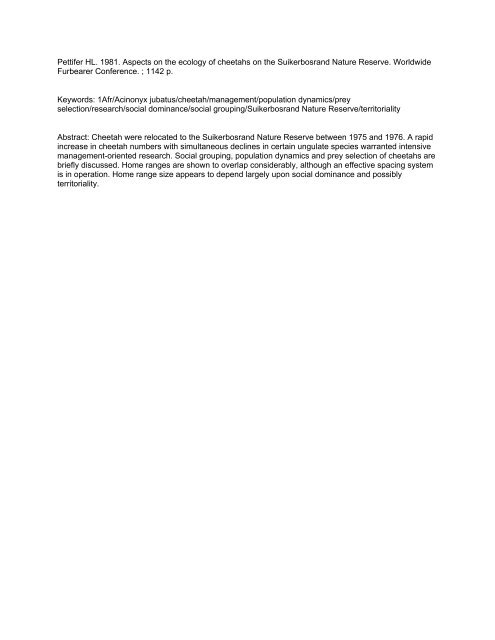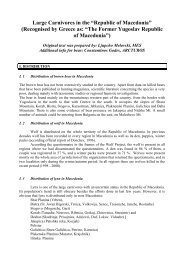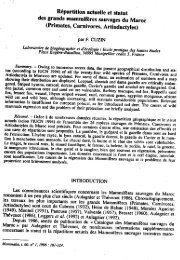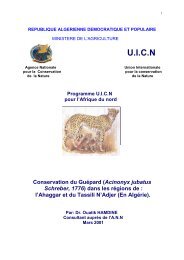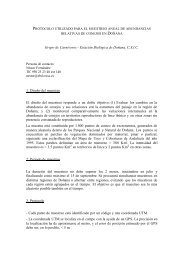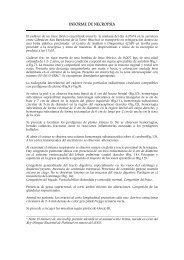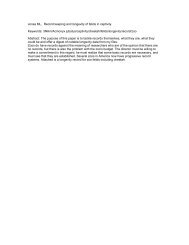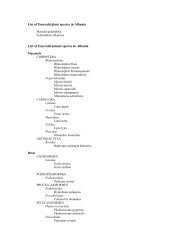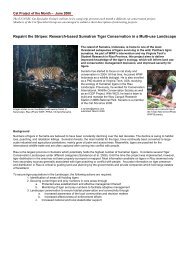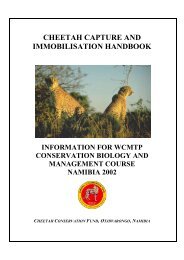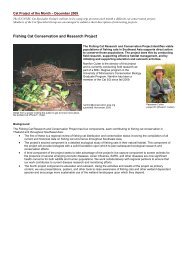Pettifer HL. 1981. Aspects on the ecology of cheetahs on the ...
Pettifer HL. 1981. Aspects on the ecology of cheetahs on the ...
Pettifer HL. 1981. Aspects on the ecology of cheetahs on the ...
Create successful ePaper yourself
Turn your PDF publications into a flip-book with our unique Google optimized e-Paper software.
<str<strong>on</strong>g>Pettifer</str<strong>on</strong>g> <str<strong>on</strong>g>HL</str<strong>on</strong>g>. <str<strong>on</strong>g>1981.</str<strong>on</strong>g> <str<strong>on</strong>g>Aspects</str<strong>on</strong>g> <strong>on</strong> <strong>the</strong> <strong>ecology</strong> <strong>of</strong> <strong>cheetahs</strong> <strong>on</strong> <strong>the</strong> Suikerbosrand Nature Reserve. Worldwide<br />
Furbearer C<strong>on</strong>ference. ; 1142 p.<br />
Keywords: 1Afr/Acin<strong>on</strong>yx jubatus/cheetah/management/populati<strong>on</strong> dynamics/prey<br />
selecti<strong>on</strong>/research/social dominance/social grouping/Suikerbosrand Nature Reserve/territoriality<br />
Abstract: Cheetah were relocated to <strong>the</strong> Suikerbosrand Nature Reserve between 1975 and 1976. A rapid<br />
increase in cheetah numbers with simultaneous declines in certain ungulate species warranted intensive<br />
management-oriented research. Social grouping, populati<strong>on</strong> dynamics and prey selecti<strong>on</strong> <strong>of</strong> <strong>cheetahs</strong> are<br />
briefly discussed. Home ranges are shown to overlap c<strong>on</strong>siderably, although an effective spacing system<br />
is in operati<strong>on</strong>. Home range size appears to depend largely up<strong>on</strong> social dominance and possibly<br />
territoriality.
Fv'ovn: \^)a,r[/.qt ]e Fu=rbea-rretr P^o
PATTIEER<br />
;;;;;; """; *:'"'::'l:u -::,ilil"'ii"il;""'ll"ll.',ll;,'li,<br />
<strong>cheetahs</strong> corlP!l3lng 5 mel6s snd 3 femeles w€re trapped in llveBtoch<br />
populatl<strong>on</strong> ht'l rlsen to an ertrd|arsq<br />
:' l:-:-'*-,* ,^*to"t"." r"."ril,i,""""""<br />
dlsmstlc dtop ln ths blesbok and spltngbok (!g!g9lS-- -<br />
olalis) numbers' An intensrve research prog'am <strong>on</strong> relocsted <strong>cheetahs</strong><br />
t-#i;;;;;"<br />
launched with <strong>the</strong> maior obJectlves <strong>of</strong> studvlns <strong>the</strong> prealator-prey<br />
relatiotrships'<br />
gopulatt<strong>on</strong> dyn&rlcs' lmvementa and aocial<br />
st ruct ure <strong>of</strong> r€locat€d chsettha'<br />
Thls Pape! lopolts <strong>on</strong> certrln asPscts <strong>of</strong> <strong>the</strong> <strong>ecology</strong> <strong>of</strong>_th€ cheetah8 <strong>on</strong><br />
an"' "'"i*"to."tt"U Netu!6 ReBorve wlth particular eophasiB <strong>on</strong> homq renge<br />
qnal movementa '<br />
STUDY ARSA<br />
I'he Suikerbosrsn'l Nrture Reserve ls situated apploxlDately 40 ltxo south<br />
;;" ;;;;;;;""'. rn tho southcentrsr rrsns'aar (2602?t - 26034's'<br />
28o09' - 28o21r8). The re6erve' compfislng somerhat 13'tl00 ha' falIs<br />
lr,nrr ^"""*"' (1953) Brnkenv€ld' ls characterize'l by predoDinantlv open<br />
€rsssveld with 'lense thiclret! in 6<strong>on</strong>e ot <strong>the</strong> ravines' Bledenkamp and<br />
n."oo (rgzo) classrfied <strong>the</strong> gra.slan'ls tnto<br />
These<br />
-13 .c.drn]l:le^:'<br />
crossland codounlties are gr€atly affected by <strong>the</strong> divelslty <strong>of</strong> <strong>the</strong> to-<br />
altltudes renge'froo 1's25 D<br />
i"".""i"-aa""<br />
- r'916 m)'<br />
The rese.ve ls blsect€'I Uy a'l ta"t-rtat rtdge' Ivo gsological forma-<br />
tl<strong>on</strong>s, namely <strong>the</strong> Vent€rsdolp Syst€o'ln <strong>the</strong> c€ntral and' $estcrn regi<strong>on</strong>g<br />
ina..;..;;. wltwstefsflnd syitgn |n <strong>the</strong> east, comprls€ <strong>the</strong> reserve.<br />
Tbe latter Syst€in has un'lorg<strong>on</strong>€ c<strong>on</strong>si'lerable faulting' loldlng and erosi<strong>on</strong><br />
(du Toit 1954) and is ret'tlv€ly g&!e-f!ee ttue to <strong>the</strong> sou' vegetati<strong>on</strong><br />
<strong>on</strong> <strong>the</strong> qualtzlte aolls'<br />
fhe reserve lies withln <strong>the</strong> suitrner rf,intall regi<strong>on</strong>' l{inters ere cold<br />
$ith icy nountain winds' surners ale leoperate with frequent thunde!'<br />
li€htenlng an'l hall slortDs' Annual rainfall varles bett€en 650 nm _<br />
rso tlrn, <strong>the</strong> maio!ity falltng b€tween October and Malch (Pigue 1)<br />
M<strong>on</strong>thly mean tninlmurn telDperrrures sle normal ly below 5o C 'luring winter'<br />
wheless <strong>the</strong> nean n<strong>on</strong>thly maxltnl,'n ternperatu'es seldom exceed 2?o C dul_<br />
lng sulflrc! (Ftgure 1) '<br />
tl22
ECOLOGI OF CEEETAES<br />
3anrvu3d l{ 3<br />
R<br />
hur||l't.lYl}|lvu<br />
1123<br />
991<br />
aa<br />
EF<br />
8l<br />
Fi<br />
!s<br />
F<br />
Ee<br />
in<br />
ii<br />
3o<br />
!;r<br />
5or<br />
xq<br />
E5<br />
i9<br />
!F<br />
sn<br />
0d<br />
sF!<br />
6UF<br />
!!E<br />
-qo Q<br />
58 g<br />
g. g<br />
.?o;<br />
EE:<br />
EXE<br />
!tE<br />
-sF<br />
gafl<br />
668
'<br />
PETTTFER<br />
::1.:1"""",T'ff ltilii,ll:#-:,*:IJl#"'ffi ,"""'x}:<br />
iit".,," t,unnu'l an'I bl ack-becxeohl"""".,<br />
"i;;";e<br />
o<strong>the</strong>r thrn<br />
iffi;";;;"'ros<br />
dstorB.<br />
ths t€Emlnal Pre-<br />
uATBNIAI.S AND UEtIIODS<br />
**'*":'* i****lll":",ff #*<br />
(<br />
r.""rt"t'<br />
^vM lnstrunent-!, ":,::t':;;;-.<br />
"'<br />
rere uasd in<br />
".:'<br />
tocatlns <strong>the</strong><br />
*i1."' ;""'."1:l;". i r:" :*'i:T;i" rl,:l' : :x',::' : :il, :ff:<br />
1?-?) wss ttequentlY uaeo rl<br />
':::-::<br />
:,:::":::1T;:*:;":l"l:#"::"":""i':'J'i""'"1<br />
t-rre grtas ( 100 m x r00':,<br />
^"i^:": i'i;; i:",i:"1:::l::'":"':ff<br />
i:jx,', ::1""","-""":;,J":":'::::l,i*;: .:":"i<br />
:n.<br />
^.^-"t<br />
lf :1"'"""1i;';;!*'rl*"i':lii';*::"" ""*,'"",'.- ;t - -$fg*,:<br />
.""r ant€nnae'<br />
lroo 9l<br />
i'!.tJ<br />
:i:ff:";; ::"lI T"';;<br />
::":"": :, :ff; T":u".T.;"'""<br />
l, T"T"": #::::::"';Jilli<br />
"""" ""' each read I ns'<br />
*j:::{iT' "#,1T J*,':: ;' "<br />
:::", ::"<br />
" 1"": "'f' " l" "<br />
li:'^r'""<br />
lnaccurrcies in plot t ing r6dio tturked "tt*t " "'t"-:::"':"":l';1"<br />
;:""1<br />
" """'i
ECOLOEI OE CEEEIAES<br />
(Tester 19?1). Plots trith angles les! than 10o were reiected and readings<br />
were taken as close to <strong>the</strong> anlmal as feasibly posaible without<br />
causing any disturbance.<br />
A fur<strong>the</strong>r problem <strong>on</strong> Sulkerbosland nas caused bv <strong>the</strong> leflecti<strong>on</strong> <strong>of</strong> sig-<br />
nsls <strong>of</strong>f <strong>the</strong> mountainous terrain. In 50 t.lal plots whele <strong>the</strong> cheetah8<br />
oere flushed after <strong>the</strong> leadings had been'taken, it was lound that al I<br />
plots except 2 fell within 100 m x 100 |l| <strong>of</strong> true locati<strong>on</strong>' <strong>the</strong> remaining<br />
z plots being 200 m out <strong>of</strong> true locati<strong>on</strong>. Botl <strong>the</strong>se plots were taken<br />
frorn distances over 4 lsn lroo <strong>the</strong> anlmal.<br />
Whe!e posslble, daily plois lf.!e takeo <strong>on</strong> all radio marked cheetaha'<br />
Each selected cheetsh was periodlcally track€d <strong>on</strong> a routine ba8is and<br />
ell data relevant to th€ <strong>ecology</strong> <strong>of</strong> <strong>the</strong> cheetshawere recorded' Behavi-<br />
oral aspects and habttat descrlptl<strong>on</strong>s rere lecorded <strong>on</strong>to nicrocasEelte'<br />
For <strong>the</strong> purpose <strong>of</strong> thls paper, ho<strong>the</strong> Fange wes bssed <strong>on</strong> <strong>the</strong> minlmrim area<br />
method (Stickle 195{) anal high utllittti<strong>on</strong> aleas calculated by plotting<br />
<strong>the</strong> geog.Sphical positi<strong>on</strong> o! th6 daily dlurnal restlng sltes <strong>of</strong> all <strong>the</strong><br />
study animels anal by progres!lvely €xcluding successive observat i<strong>on</strong>€<br />
that c<strong>on</strong>tllbut€d <strong>the</strong> most to <strong>the</strong> totsl hotne lang€ slte, u|rtil a deflnite<br />
co!e area remained which c<strong>on</strong>slstGd <strong>of</strong> observat i<strong>on</strong>s thf,t were closely<br />
situateal to each o<strong>the</strong>r. Ttlese calculetl<strong>on</strong>s were mad€ using a Fortran<br />
prog!am <strong>on</strong> a Bulroughs B 6?00 digital cooputer as used by FerguB<strong>on</strong><br />
(1980). The lnitlal plotting <strong>of</strong> <strong>the</strong> localities <strong>of</strong> each ch€etah *as<br />
performed using s Versatec Plottet coupled to a Cyber l?4 digital com-<br />
STUDY ANIMALS<br />
The 1st cheelah was radlo marked <strong>on</strong> 4 July 1978 <strong>on</strong> <strong>the</strong> suikerbosrend<br />
Nature Reserve. The anlmal nas an approximately 18-np-old femele<br />
(Puldey) origtnating from a group <strong>of</strong> 4i <strong>the</strong> o<strong>the</strong>r 3 wer€ relocated to<br />
<strong>the</strong> Eastern Shores Nature Beserv€ ln Natal. On 26 July l9?8, an adult<br />
female (Mary) with 4 3-mo-old cubs was !adio marked, followed bv an<br />
sdult fenale singlet<strong>on</strong> (Rosina) <strong>on</strong> 18 September l9?8. On 23 Sept€mber<br />
l9?8, 2 aalult males ((ojak and setzure) wer€ malked' bringing <strong>the</strong> total<br />
to 3 females and 2 nales, Al I those cheetshs are st I I I under study'<br />
tt25
PEI!7FER<br />
All <strong>the</strong> stualy ehlmels wete rmoblllted uslng ketadlne hydrochlori'le<br />
mtxed to 250 mg P6l ml at <strong>the</strong> dosage rate oI 12 mg pe! Lg' z€ro point<br />
flv6dilllllt6!s4pefcentRoq'un(xylszlnehydfochlorldelBAyef)wae<br />
adaled to each doso.<br />
RESULTS<br />
socl al structuro<br />
Throughout th€ study perlod th€ radlo marke't fenales nere ei<strong>the</strong>r single-<br />
t<strong>on</strong>"-o.".oor4rr,,te'tby<strong>the</strong>lrcubs'Th€lr<strong>on</strong>lyphysicalencounte'with<br />
o<strong>the</strong>r <strong>cheetahs</strong> <strong>on</strong> <strong>the</strong> r€asrve trs durln8 matlng wlth I ot <strong>the</strong> 2 ladio<br />
marked oele6' Th€se males 9er6 <strong>on</strong>ly s€palsted lrqn €ach o<strong>the</strong>r during<br />
mating encounters, which s€ldoo laste't l<strong>on</strong>g€' than ' dey3' seizure<br />
mate.twithPuldeyandBostne'hil€ltagpegrsdthst(o,akmtedf,ith<br />
Mdry. All sighttngs <strong>of</strong> urDAlted ch€etehs <strong>on</strong> <strong>the</strong> reselve $€!e also <strong>of</strong><br />
singlet<strong>on</strong>s o! feoales accoq)snle'l by cubs' Mixe'l groups 'ere not en-<br />
Populetl<strong>on</strong> DYnamlcg<br />
fhe total cheetah populatl<strong>on</strong> <strong>on</strong> Sutk€'bosland was estlorted at between<br />
29 and 31 ln December 19?9 (Pettlf€r et al' 19?9)' slnce that report'<br />
Uaay rt." ptoa,r"eC 6 cubs' llcr cub3 lroE h€! Pr€vious lltte! $€le relo-<br />
"rt"a to ttr. easteln Trensvf,al ' A tur<strong>the</strong>r 1l cheetah heYe been relocat-<br />
.U ,o ntrot. Reillr'vea ln <strong>the</strong> Cr9€ Provlnce' Nrtal and eaatern Tranavaar<br />
betreen JulY 19?8 and Deceder 1979'<br />
trrom July 19?8 to date 8 lltlels totaftng 33 cubs hevs been captuled and<br />
g|alkeal. <strong>the</strong> sex latio o! cuDs tras 13 Eales:20 females' with a m€an lit_<br />
ter sizs <strong>of</strong> {.13- (rango 3 _ 6)' Mortality <strong>of</strong> cubs ls lotr wlth <strong>on</strong>lv 5<br />
lo3ses 6m<strong>on</strong>g <strong>the</strong> r33 malked cubs (15'15 Percent) '<br />
Hoo€ Ranges <strong>of</strong> Raatlo Marksd Cheet ah3<br />
defined a6 <strong>the</strong> alea habltually tlaversed bv sn indivlduar<br />
tlom range ia<br />
activltle! withln a specltlc perlod ot tlioe (Brown 1966)<br />
ln i ts nomal<br />
e:(cluded randqs exculsl<strong>on</strong> ttlps out o( th€<br />
Butt (1943)<br />
t].26<br />
'
ECOtrOCT OP CEEEIAES<br />
range, but becsuse <strong>the</strong>se €xcuralga ttlp3 are <strong>of</strong>ten repeated tn <strong>the</strong> cheetchs,<br />
th€ defintti<strong>on</strong> descrlbed by Xoeppl et al. (19?5) waa applied<br />
whereby <strong>on</strong>ly <strong>on</strong>e-tiEe excursl<strong>on</strong> tiips that rere c<strong>on</strong>sldorebly bey<strong>on</strong>d <strong>the</strong><br />
normal hooe range were omitted. Accoldlngly by calculating <strong>the</strong> 95 per-<br />
cent home range atea, it was found that a more reallstic pattern ol horo€<br />
rangea <strong>on</strong> Suikerboarand waa achieved.<br />
The horn€ rangee <strong>of</strong> <strong>the</strong> che€taha <strong>on</strong> Suikelboarand as described in lhis<br />
paper were calculeied <strong>on</strong> <strong>the</strong> lo(hlities <strong>of</strong> diurnal resting eites. Ahls<br />
nethod 3ho{s ltttle dtfference ovsr 3 l<strong>on</strong>g period <strong>of</strong> tlme to co|rt lnuous<br />
half-hourly plota over a ahottet perlod (<str<strong>on</strong>g>Pettifer</str<strong>on</strong>g> in pr€p.).<br />
By <strong>the</strong> calculatl<strong>on</strong> <strong>of</strong> <strong>the</strong> 50 percent horDe lange, tho uniforrrity <strong>of</strong> ho|!e<br />
lange ua€ or <strong>the</strong> c<strong>on</strong>velae can be rordily deterrDlned. Tho Bizes <strong>of</strong> <strong>the</strong><br />
50 percent and 95 pe.cent hdre rangea <strong>of</strong> th€ 3tudy anlEals rre glven in<br />
Table 1.<br />
Table 1- Ths nud€r <strong>of</strong> lrdlo-t.leoetry flx€s <strong>on</strong> dally dlurnal resting<br />
sltos snd size6 <strong>of</strong> <strong>the</strong> 50 p€rcent and 95 percent hooe ranges<br />
<strong>of</strong> rodlo marked che€teh3 <strong>on</strong> <strong>the</strong> Sulkerbo8rand l{atule Roserve,<br />
(All data through Dec€rnbst 1979)<br />
Individual<br />
Purdey<br />
Mary<br />
Ros ina<br />
Kojak and<br />
Seizure<br />
Dat e<br />
Morked<br />
{ Jul 19? 8<br />
26 Jul 19?8<br />
18 Oct 19?8<br />
23 oct 19 78<br />
Nudsr <strong>of</strong><br />
Deys Plotted<br />
161<br />
l6?<br />
lr3<br />
I5l<br />
Sl !e <strong>of</strong><br />
95 perc€nt<br />
Home Rtnge<br />
(l
PE?TIFER<br />
tt28<br />
E c<br />
p8.<br />
eE<br />
hp<br />
ae<br />
€-<br />
!€<br />
6A<br />
€.9<br />
Jl9<br />
ME'<br />
d-bl<br />
9- F<br />
u^<br />
E &B<br />
!^a<br />
P 95<br />
!qI<br />
s$8<br />
ndt<br />
Hr<br />
Ti<br />
JAiL<br />
t;r -ea<br />
'aE<br />
. q<br />
o*r<br />
efr<br />
t, &,
ECOLOE| OF CAEE?A|S<br />
reserve. Thls can be ascribed to <strong>the</strong> c<strong>on</strong>staterable tim€ she spent 1n<br />
this area alurlng whelplng <strong>of</strong> her cubs tn early June l9?9. Throughout<br />
June she r€rDa<br />
ineal ln thls area, but <strong>on</strong> 2 occasl<strong>on</strong>s rfas observed as far<br />
a6 7 ls! away fro|D her cubs. lVhlll€ s sldglet<strong>on</strong>, purdey appearod to roaD<br />
ad lib throughout her home renge end wes noteal to have trqversod largo<br />
secti<strong>on</strong>s ol thc leserve tn a slngte aldy. The iol'Ied plots tndlcato c<strong>on</strong>_<br />
secutive deys. The greatest straiBht-llne distence between c<strong>on</strong>secutive<br />
diurnal re8tlng Bltea was 8.? lq[,<br />
Mary (Figure 3) had a s<strong>on</strong>ewhat snaller hode range than purdey or Rosina.<br />
Her 50 p€rcent home range iras slgniflcantly less than halt <strong>the</strong> 9, p€r_<br />
cenl hooe rangs (x' = 23,83, p = 0.05), iDdtcsrtng a definit6 area <strong>of</strong><br />
preference. llery re6 accoq)rnted by 4 cubs when msrkeal. These cubs<br />
broke ti€3 {lth her durtng Sept€ober l9?9. She ploduced 6 cubs durlog<br />
December 19?9. She rhelped th€.e cubs ln <strong>the</strong> pr€terreat area and with<br />
both llti€rs t€ualned reag<strong>on</strong>abty wtthtn thts area. She dlat, nowev€r,<br />
undertake aeveral 6rcursi<strong>on</strong> t!lp!, f,hIch c ffered lrm those ot <strong>the</strong><br />
oales ln <strong>the</strong>t <strong>the</strong>y norfielly stretcheal ove! 6evetal days, wlth <strong>the</strong> ex_<br />
cepll<strong>on</strong> <strong>of</strong> those to <strong>the</strong> er6t <strong>of</strong> <strong>the</strong> leaerve. T}reae excursl<strong>on</strong> trips<br />
greatly influencod <strong>the</strong> atetelntnatl<strong>on</strong> ot h€! horne rango. Although itsry<br />
had a Eore predictable horp rsnge, end dlstances between c<strong>on</strong>secutlv€<br />
diurnal rostlng slt€s ner€ nolmallJr shott, she dld <strong>on</strong> occasi<strong>on</strong> movo c<strong>on</strong>_<br />
6iderable distances ln a stnglo day - <strong>the</strong> greatest st.alght_ltne dis_<br />
tance being 12.5 t(d. Roslna (Ftgu!€ 4) showed a sleilar untform utllt_<br />
zati<strong>on</strong> <strong>of</strong> h€r 95 percent hoDe range to pur
PETTIFEN<br />
;P^<br />
3a<br />
nk<br />
.gs<br />
E9<br />
EE.<br />
n5)<br />
{,e<br />
gP<br />
P 9<br />
9*<br />
:IT<br />
-B<br />
E8<br />
g.s<br />
u&<br />
E A<br />
ET<br />
Et<br />
En<br />
d d<br />
bni<br />
9n<br />
tf<br />
60<br />
>q<br />
-(9<br />
dl
ECOLOEI OF CEEEIAES<br />
1131<br />
EE<br />
pc<br />
! *<br />
ft&<br />
TA<br />
-!o<br />
.88<br />
6I<br />
'E<br />
;i<br />
d 6<br />
*a<br />
ol<br />
6&<br />
,tI<br />
FEA<br />
?.E;l<br />
3r r<br />
-g<br />
9e<br />
tda<br />
oi5 B<br />
L€<br />
"i! g<br />
h3i<br />
9te?<br />
EUU<br />
Y Iu<br />
!9tI<br />
|i3F<br />
>,o d'<br />
t{ P<br />
Afi ra<br />
;{d.<br />
p€T<br />
E 5A
PETTI?ER<br />
11.32<br />
EP<br />
zR<br />
€-8<br />
n-<br />
!0<br />
Ee<br />
a8<br />
gt<br />
oQ<br />
Ef<br />
de<br />
I fl^<br />
Eg6<br />
E",<br />
o 8"<br />
q e^<br />
s8E<br />
!a:{<br />
"Eb<br />
99tF<br />
ilpd<br />
E PTr<br />
" 8 6<br />
tirF<br />
{RI<br />
?.q -<br />
it!<br />
8 F:<br />
u? o<br />
E{t<br />
o!a<br />
99flF<br />
. g<br />
.d6<br />
gi-<br />
a8r E<br />
t &v
ECOLOCI OF CEEETAIIs<br />
preterred rrea. Several Bhort durati<strong>on</strong> excursl<strong>on</strong> trtps occurred, <strong>of</strong>teo<br />
over reaa<strong>on</strong>qbly la.ge distances. ftey c<strong>on</strong>slstently !eturned to <strong>the</strong>ir<br />
preferred area <strong>the</strong> followlng day with <strong>the</strong> excepti<strong>on</strong> <strong>of</strong> d few excursi<strong>on</strong>s<br />
to <strong>the</strong> l,est <strong>of</strong> <strong>the</strong>lr plefe!led aree (this area was lncluded tn <strong>the</strong> 60<br />
percent home range).<br />
In all cases <strong>the</strong> radio marked chestah3 geldoD returned to th€ ldenticat<br />
spot even when <strong>the</strong>y had spent c<strong>on</strong>siderable itDe withtn en area. No tree<br />
or bush could be identlfied as a regutar visiting site. The selecti<strong>on</strong><br />
<strong>of</strong> sleeping o! le8ting sites was opportunlstic with <strong>the</strong> provisi<strong>on</strong> that<br />
<strong>the</strong> site <strong>of</strong>fered a clear panorainlc vlew <strong>of</strong> <strong>the</strong> sulrounali[g area _ normally<br />
Eituated <strong>on</strong> hlgh glound.<br />
Cheetah ilovements i|| Relatl<strong>on</strong> to Pley Movements<br />
The cheetaha <strong>on</strong> Suikerbosland hunt predoDinently lflthtn <strong>the</strong> shaated a.eas<br />
Bhown in Figure 6. These areaa c<strong>on</strong>cur rtth th€ pleferreat habttats <strong>of</strong><br />
blesbok and 3pringbok <strong>on</strong> <strong>the</strong> reselve. Although <strong>cheetahs</strong> are com<strong>on</strong>ly<br />
regarded aa animals ol vast open pl&lns, <strong>the</strong> c<strong>on</strong>lrary rras observed et<br />
Suikerbosrand. fhe <strong>cheetahs</strong> tended to uttllze th6 slopes and lavrnes<br />
snd very seldoD ventured out <strong>on</strong>to <strong>the</strong> plains. They dtd, however, f!e_<br />
qu€ntly ro&t| <strong>the</strong> lmaller plateeus and open valley bottoms where, al<strong>on</strong>s<br />
with <strong>the</strong> slopes, <strong>the</strong> rDajortty ol kllls wer€ maale.<br />
<strong>on</strong> no occaal<strong>on</strong> $ere <strong>cheetahs</strong> obderveal<br />
length <strong>of</strong> time. I.tre genelsl tlend was<br />
fill, <strong>the</strong>n vacate <strong>the</strong> area.<br />
Predator-pr€y Relat l<strong>on</strong>ships<br />
to follo$ prey herds for any<br />
to Dake <strong>the</strong>ir kill, eat <strong>the</strong>i!<br />
Slesbok are <strong>the</strong> prlnclpel prey spectes <strong>of</strong> cheetehs <strong>on</strong> Suik€rbosrsnd.<br />
Iable 2 sumDerizes prey spectes ateftcits <strong>on</strong> <strong>the</strong> teserve between November<br />
l9?8 anal November r9?9. ,Ibese dat a x€r€ accrued by dtrect observsrr<strong>on</strong>s <strong>on</strong><br />
cheetah kilts as eelt rs lroln carcesses recorded du!ing regular line-<br />
srveeps c<strong>on</strong>ducteal <strong>on</strong> th€ reserve. Although not all <strong>the</strong> aleficits can De<br />
o8cribed to cheetshs, tt can be safely postulated thdt <strong>the</strong> majortty <strong>of</strong><br />
<strong>the</strong>ln were cheetah kills. Of pa.ttculsr interest lB <strong>the</strong> htgh propoltr<strong>on</strong><br />
<strong>of</strong> blesbok le rales arld juv€nll€s sel€cted.<br />
1133
PETIIFER<br />
1134<br />
I<br />
o<br />
E<br />
R<br />
e<br />
6<br />
I<br />
E<br />
p<br />
I<br />
A<br />
a<br />
€<br />
d<br />
Ii i[^<br />
ii6<br />
ES<br />
6n<br />
9 ;<br />
Ffi<br />
9'l<br />
td
ECOLOCI OE CEEETAES<br />
Table 2. Recorded cheetah kills and carcaaaes located in <strong>the</strong><br />
<strong>the</strong> Sulkerboara[d Nature Reserve belween Novembe.<br />
Novenber 19?9.<br />
Spec i eg<br />
aleBbok<br />
Dami I i scu8<br />
FFrrfpsI-<br />
Spfingbok<br />
deraupiallg<br />
Du ike r<br />
Sylvicapra grlmlr<br />
Crey Rhebuck<br />
Pelea capr6olua<br />
Mountaln_ Reedbuck<br />
Reduncr fulvorufula<br />
Or ibi<br />
ourebl a<br />
ou!ebi<br />
Steenbuck<br />
Raphlceru6 capl,esttl s<br />
Untdent i fl edb<br />
fleld <strong>on</strong><br />
19?8 and<br />
Sex/Age<br />
Not<br />
r(u)" r(r) Yes.l ings Lambs Determined Total<br />
l3<br />
49<br />
",r = "aoit.<br />
_Comp!lses pledo inrntly tho fenrles <strong>of</strong> ortbi, steenbuck, rDountaln reeal-<br />
ouck and grey lhebuck.<br />
Proo regular hellcopter cenauaea <strong>on</strong> <strong>the</strong> reaolve anal <strong>the</strong> careful m<strong>on</strong>ltor-<br />
lng <strong>of</strong> <strong>the</strong> bl€sbok lsDbing sees<strong>on</strong> r total deftcit <strong>of</strong> 286 blesbok was<br />
lecordoal between S6ptettrb€r 19?8 and August 19?9, gtvlng a total bl€sbok<br />
tDrtality to che€tah lrtlo <strong>of</strong> 11.6 per annur lbaseal <strong>on</strong> a ch€etah popula-<br />
tl<strong>on</strong> ol 23 (Pettlt€r et sl. l9?9)1. wlth tho cheetah populati<strong>on</strong> at<br />
rpproxillately<br />
30 (Deceder 19?9) <strong>the</strong> postuleted blesbok nortslity fot<br />
1980 wlll be ln oxcesB <strong>of</strong> 3tg, Thts excludes atl oth€r pr€y sp6ctes.<br />
1135<br />
33<br />
l1<br />
2l<br />
128<br />
20<br />
15<br />
32<br />
2L5
DISCUSSION ^NO OtCr,us I<strong>on</strong>s<br />
Soclal Structule<br />
PRIITFER<br />
Eat<strong>on</strong> (19?0s,b, lg?t) roport€d adult groups c<strong>on</strong>sistlng <strong>of</strong> both sexes in<br />
ch€etaha ln <strong>the</strong> l{sirobt Nrtl<strong>on</strong>al park, Wlog€rr|ann (19?E) 6tates, hor{_<br />
ever, that Mcleoghlln's 6tudy <strong>on</strong> che€tlhs tn <strong>the</strong> sane palk shored no<br />
Ioixed adult groups. clahrrD anat parker (196S) recorat€d mlxed adult<br />
groupa froc a questl<strong>on</strong>nalre sutvey, Schslle. (19?2) reported a 6tmilar<br />
aoclal st.ucture lor <strong>the</strong> Serengstt as that at Sutkerbosranat wrtn adult<br />
alnglet<strong>on</strong>a, sEAll all-Dele groups an
BCOLOGT O? CEEEIAES<br />
particulat <strong>the</strong> spotted hyene. Slnce <strong>the</strong> ch€otah ls <strong>the</strong> termlnal preda-<br />
tor <strong>on</strong> Suik€tsland, thls hypoth€sls was fur<strong>the</strong>r Bupporled by <strong>the</strong> low<br />
mortelity late <strong>of</strong> cub8 at Suikelbosrand.<br />
Data <strong>on</strong> sex rstlos ot wlld che6tehs are scsnty' Schaller (19?2) dtd'<br />
however, !€po!t a ser latlo ln faYor <strong>of</strong> f€males, as dtd wrogelDann (1975)<br />
ln he! sumDary ol <strong>the</strong> lltoratuFe. A polnt trorth menti<strong>on</strong>lng 13 thst <strong>the</strong><br />
sex .atlo <strong>of</strong> cubs <strong>on</strong> Sull
it"::':::':1.::'1."1,;",:"I:;.""""'<br />
PETIITEA<br />
schar re' (1e6?) arso found r€msre<br />
*:*""*ruq"*lln:il<br />
**r*+***:u<br />
rr*',rurt****+**r<br />
*: :, *':';""." ":r' :::' """::"<br />
***i'n***;**ttirut<br />
Pretlator_Prey Rel at i<strong>on</strong>shlP'<br />
and afe encoun_<br />
"l""l;:;;i",*"'i:"'l:,{i$l<br />
Nrllobi Nat l<strong>on</strong>al Prrk'<br />
"i";x :*<br />
anal iuvenll€<br />
*ki:: t'x""i# I ui ;im'1"<br />
th€ llteretur<br />
5l Detcent (<br />
113a<br />
than 20. Oree-<br />
helds (Petttler<br />
( 19?0b) in thr
ECOI.OCI OF CEEETAES<br />
Thomps<strong>on</strong>'a sarelle (99!glq<br />
1!9qp!99) killed by <strong>cheetahs</strong> were gubadult<br />
and that <strong>the</strong>re appea.eal to bo no seloctl<strong>on</strong> for rex ln ihs adult class,<br />
rhe.eas Kruuk rnd Turne! (196?) found a plefere|rce for adult f€r[ales in<br />
<strong>the</strong> same species. Lik€wise, ptey 3peciea selectl<strong>on</strong> appears to vuy, for<br />
exornple Pie|rarr (1969) found leedbuck (Bedunca arundtnun) to be rn lmportant<br />
prey species in <strong>the</strong> Xruge! Nati<strong>on</strong>al Park, rhll6 Mltchell et al.<br />
(1965) found reedbuck not to be lmportant at Kafue Nati<strong>on</strong>rl Park, Zam-<br />
bia, even though <strong>the</strong>y were more abundint <strong>the</strong>ae.<br />
Xruux and Turner (lg8?) poEtulrted that selectl<strong>on</strong> for feoale prey could<br />
be due io feoaler tl.elng lst snd thuB sttmulatlng <strong>the</strong> <strong>cheetahs</strong> to glve<br />
cha6e. Eat<strong>on</strong> (19?2) Bhowed expe!iDentally that <strong>the</strong> flight ol prey re-<br />
leasea at t ack in <strong>cheetahs</strong>.<br />
Eat<strong>on</strong> (19?0b) elao atated that thcro rpDear8 to be a dlffelential 60lec-<br />
tl<strong>on</strong> for females rnd Juvenilcs. On Sulkerbosranal, <strong>the</strong> aslectlor| lor<br />
fsDalea and iuvenlle3 could b6 due to <strong>the</strong> alr. celeSoty <strong>of</strong> <strong>the</strong> pr6y.<br />
Adult male blesbok relgh ov6r 80 kg. El6abok ere not eglle rnimala lnd<br />
lndividual aelecti<strong>on</strong> ia thue mral6 ee6l€r.<br />
Implicall<strong>on</strong>s <strong>of</strong> Cheetah <strong>on</strong> <strong>the</strong> Suikerbosrand Nature Reaerve<br />
The reproductlve succesa ot che6trha <strong>on</strong> Suikerboarand has already led to<br />
<strong>the</strong> relocrti<strong>on</strong> <strong>of</strong> l6 che€trhs. A almultaneouB ph€noh€nal breedlng succes8<br />
<strong>of</strong> cheetshs in captlvlty hea been achleved at <strong>the</strong> De Wlldt qreetah<br />
Breedlng Stetl<strong>on</strong> noer Pretorlr. The rdvantsge <strong>of</strong> th. Suikelbosrand<br />
cheetah8 ls, however, <strong>the</strong> tact thrt <strong>the</strong>y are bo.[ anal r€ared ln <strong>the</strong> wild<br />
and are thus eaally reloc|ted to [rtural ar€aB, although lt has also<br />
been establlshed that capt lye-bred cheetah6 otry adapt to lile ln <strong>the</strong><br />
l{i ld (Pet t t l€r 1S81).<br />
The success <strong>of</strong> che€tahs <strong>on</strong> Suikerbosarnd ls not wlthout lts repotcus-<br />
sr<strong>on</strong>s. Wlth <strong>the</strong> r.apid lncreaae <strong>of</strong> cheetaha, e alrertlc reduct l<strong>on</strong> ln cs!-<br />
taln prey species, prrtlculerly bl€sbok and sprlngbok, has followed. tn<br />
<strong>the</strong> absenc6 <strong>of</strong> oth€r lsrge predrtors, limttlng fuctors lfhlch could opor-<br />
ate <strong>on</strong> <strong>the</strong> cheetrhs <strong>on</strong> Sulkorboarand at p!€sent rre depl6tl<strong>on</strong> <strong>of</strong> food<br />
resourcea, dl6€rae, end soclal lntol€rrnce. At pr€a€nt, n<strong>on</strong>e <strong>of</strong> thsa6<br />
factore appeer to have dny slgntllcant ln!luence.<br />
1139
PE??ITER<br />
Suike.bosranat' being sltuat€d close to Johann€sburg' ls sn ilDpo'tant<br />
l"io"." """."r,t"n c€nte' wlth gane-vlewing as an integral To<br />
-facet'<br />
allov.lh€cheetshpopulatl<strong>on</strong>to6tablll'eby.Iepleti<strong>on</strong><strong>of</strong>ltsotinfood<br />
""nnt" ."" thus not be c<strong>on</strong>sldered' lhe cheetah populati<strong>on</strong> will <strong>the</strong>!e-<br />
fore always have to be managed'<br />
One <strong>of</strong> <strong>the</strong> mejor questi<strong>on</strong>s that now alises is to flhat lev€l should <strong>the</strong><br />
Ii""i.n n.n"t"tt"n<br />
be managed? Ths establlshm€nt <strong>of</strong> a safe cheetah to<br />
;;";;.,;.'ls comPllcated bv <strong>the</strong> obvious selecti<strong>on</strong> <strong>of</strong> <strong>cheetahs</strong> <strong>on</strong> this<br />
;:.;.-';;' fenal; blesbok' Ful<strong>the</strong>mo'e' exPerlence h63 shown that <strong>the</strong><br />
,r"npt", .t cheetshs is boih oxpenslve an'l tloe_c<strong>on</strong>sumlng wtt}I rrs own<br />
;;;;i",;."" in thst certain lndlvlduals ere repeatedlv captured' wh€!eas<br />
oth€rs act ivelY avold <strong>the</strong> traps'<br />
At piesent' <strong>the</strong> hlesbox popul'tl<strong>on</strong> ls bsing augmented by exce33 3tock<br />
;;;-;;." ."""."es' Thi6 wtll plobablv hsvs to be c<strong>on</strong>tinued-untll such<br />
;i;;;; ,". blesbok reach n.nbers i<strong>the</strong>rebv <strong>the</strong>lr lncrement will sreatlv<br />
"".n""'.o.ple.laii<strong>on</strong>l.atetoAllo'o!<strong>the</strong>cfopping<strong>of</strong>excesifasato<br />
balance out ths aer ratio'<br />
The r€search et Suikerbosland is belng c<strong>on</strong>tinue'l in otder to flnd a<br />
plact I cal tuoagement PolicY'<br />
ACKNS{LBDCMBNTS<br />
Thls study could not hrve b€en unde'tekeD wlthout <strong>the</strong> suPport rnd enthusis$6<br />
<strong>of</strong> Iny flel'l technlctsns foos 'le lfet snd Piet M\rller - to <strong>the</strong>m a<br />
speclal word <strong>of</strong> than}s '<br />
J.W.H. F€lgus<strong>on</strong> was a great help tn <strong>the</strong> final computatl<strong>on</strong> ol data and<br />
c!ltlcally revlewed this paper' The staft <strong>on</strong> <strong>the</strong> Suikerbosland Nature<br />
Reaelve are thanke'l for <strong>the</strong>lr help ln oany rays' D!' E' Young and s'<br />
wolffarescknowlettg€droru'efurco@ntthfoughout<strong>the</strong>dufatl<strong>on</strong><strong>of</strong><br />
this study. The Problem Anlmel C<strong>on</strong>trol Unit' T'tnBvaal Divlsl<strong>on</strong> <strong>of</strong> Na_<br />
ture Crnservati<strong>on</strong>' was r€sP<strong>on</strong>6ible fo! |mst ot <strong>the</strong> trspptng <strong>of</strong> cheetshs<br />
<strong>on</strong> <strong>the</strong> resetv€' <strong>the</strong> Director <strong>of</strong> Nature C<strong>on</strong>selvatl<strong>on</strong> granted p€rttl6si<strong>on</strong><br />
to atl€nd <strong>the</strong> C<strong>on</strong>ference an'l Publish thl3 paper'<br />
1140
LITERATURE CITED<br />
ECOLOGI OF CEEEIAES<br />
A@CI(S, J.P.H. 1953. Veld types <strong>of</strong> South Afrtcs. Mem. ,Bot.<br />
Sulv.<br />
South Af!ice 28. Gov€rrrd<strong>on</strong>t Prlnler, Pletoria, South Africa. 192<br />
pp'<br />
sREoEixAiP, G.J., ard G.K. THBRoI. 19?6. vegetati<strong>on</strong> units for managem€nt<br />
ot <strong>the</strong> grasslands <strong>of</strong> <strong>the</strong> Suikelbosrand Nature R€8erve. South<br />
Afrlcan J. ltildl. Re3. 6:113-122.<br />
BROWN, L.E. 1966. Holhe ra[ge and movement <strong>of</strong> Bmall ma|Imal6. symP.<br />
Zool. Soc. , L<strong>on</strong>d<strong>on</strong> l8:111_142.<br />
aURT, w,H. 1943. ?errltoriality and holDe rqnge c<strong>on</strong>cepta aa appl ied to<br />
Ina|Imals. J. M&Imal. 24:346-352.<br />
COHAN, M., A.T. SCHOLTZ, and G. REICHEL. 19?8. A prelimtnarv survey <strong>of</strong><br />
<strong>the</strong> ch€etah, Actn<strong>on</strong>yx tubatu3 <strong>on</strong> <strong>the</strong> Sulkerboarrnd Nature Reaerve.<br />
Tlansvaal Dtvl-fliT. dottee!%, Pletorla, south Aftlca. (Mineo).<br />
Du T0IT, A.L. 1954. rhe Geology <strong>of</strong> South Atrica. 3!d ed. Ollver and<br />
Boyd, Edlnburgh, Scot land.<br />
EAION, R.L. 19?04. Group lntslactl<strong>on</strong>s, spacing and territorlallty in<br />
cheetah8. Z. Tlerpgychol, 27:481-491.<br />
. 19?0b. llu[ting beheviour ol <strong>the</strong> cheetah' J. wlldl.<br />
-----Mi;Ee.34:56-6?.<br />
. l9?2, Ao expe!imentsl study <strong>of</strong> plealatory and feedlng be-<br />
------Taniour<br />
ln <strong>the</strong> cheetah ( Acin<strong>on</strong>yx lubatus). z. Tierpsychol.<br />
31:2 70-280.<br />
. 19?4. Tho Cheetah. The Biology, Bcology and Behaviour <strong>of</strong><br />
-----_-I'-Edangered<br />
speclos. van Nostrand Beinhold Co., New Yo!k' N€w<br />
Yo.k. 178 pp.<br />
FERCUSON, J.W,H. 1980. Die Ekologie van die Rooiiakksls Cania oeaomel;s<br />
schrebe. 1??8 met spesia-le verwysing na Beweginge-En-3oETa-Te<br />
O;Ean-tsasie. u.sc. Thesls. lJniv. Pretorla, Pretorla, South<br />
Africa.<br />
cR^llAlr.l, 4.D., and I.S,C. PARI(BR. 1965. East African Wildlife Socletv<br />
cheetah survey: r€port by nildlife Serylc€s. East Africsn lflldl.<br />
Soc. , Neirobi, Xenya. (Mtmeo).<br />
REEZEN, It.L., and J.R, TESTAR. 196?. Evaluatt<strong>on</strong> <strong>of</strong> radio-tracking by<br />
tliangulatl<strong>on</strong> wlth special leference to deer moveBents. J. Wlldl.<br />
Manage.31:124-111.<br />
JOUBERT, 8., end P.X.N. I,OSTERT. 19?5. DiBtributi<strong>on</strong> patterns and<br />
status <strong>of</strong> a<strong>on</strong>e martrnal a in South West Africa. Madoqua 9:5-l{.<br />
KoEPPL, J.W., N.A. SLADE, and R.S, HOFFMAN. 19?5. A btvqrtete hooe<br />
range rrcdel wlth posslble epplicati<strong>on</strong> to ethological data. J.<br />
tratlml.56:81-90.<br />
KRoUX, H., and U. TURNER. 196?. Comparative notes <strong>on</strong> predatl<strong>on</strong> by<br />
ll<strong>on</strong>, leopard, che€teh and lild dog in <strong>the</strong> Sere[geti atoe, East<br />
Afr i ca. r,Iatmal is 31:l-2?.<br />
MITCHELL, 8.L., J.B. SHEI{TON, anal J.C.U. UYS. 1965. Predati<strong>on</strong> <strong>on</strong> large<br />
mallmals in <strong>the</strong> I(afue Natl<strong>on</strong>rl Park, Zambla. zool. Africana<br />
1:29?-318.<br />
MyERS, N, 1914. lnstitutl<strong>on</strong>al lnputs lor cheetah codservrtl<strong>on</strong> ln<br />
Africe. Trens. 39th N. An. fltldl. c<strong>on</strong>f. Pp. 323-331.<br />
-_T-ome . 19?5. The cheetshrs 16latl<strong>on</strong>shlP to <strong>the</strong> spotted hydena:<br />
tmpttcatl<strong>on</strong>s lor a thlertened species. Proc. 19?5 Pred.<br />
Synp., Untv. ll<strong>on</strong>tana, Miaaoula, M<strong>on</strong>tena.<br />
It41
. 19?6.<br />
---E.i6r?-61?.<br />
PET?IEEN<br />
The cheetah in Alrica unde! threar. Env. Aff,<br />
NOBLB, G.I(. 1939. The role ol domlnance in <strong>the</strong> social life <strong>of</strong> birds.<br />
Auk 56:263-2?3.<br />
PETaIFEB, H.L. <str<strong>on</strong>g>1981.</str<strong>on</strong>g> The exp€rlmenlal release <strong>of</strong> captive-bted cheetah<br />
lnt; <strong>the</strong> naturel envlrorunent. In: Wo!ldwldg Furb€arer C<strong>on</strong>te'ence<br />
Proceealings (J.4. clrapnsn and D: Pursley, eds.). R'R' D<strong>on</strong>nelley<br />
and S<strong>on</strong>s. Co., Falls Church, Vlrgltla.<br />
, J.l. De ltB?, and P.J. UJLLER. r9?9 The <strong>ecology</strong> <strong>of</strong><br />
-<br />
chA;TiE-_( Acln<strong>on</strong>vx lubalus) <strong>on</strong> <strong>the</strong> suikerbosrand Natule Reselve.<br />
-b-iv, -liit:--6nTerv.<br />
Trensvaal , Pretoria, South Africa. (Mimeo).<br />
PIANAAR, U, de v. 1969. Predrtor-prey relrtl<strong>on</strong>shlp3 am<strong>on</strong>gst <strong>the</strong> rarger<br />
mardnals <strong>of</strong> <strong>the</strong> Xlug€r Natl<strong>on</strong>al Park. Xoedoe l2:108-l?6'<br />
SCIIALLEB, O.B. 198?, -The Deer rnd <strong>the</strong> Tiger. University <strong>of</strong> Chicago<br />
Pre83, Chicago, Illinois.<br />
. 1d68. HunttnB behavlour <strong>of</strong> <strong>the</strong> cheetah in lhe Serengeti<br />
-------neiTfiiT<br />
Park. East Afrlcan wlldl. J. 6:95-100.<br />
. l9?2. The Ser<strong>on</strong>get I Ll<strong>on</strong>. Unlverslty ot chlcago Press'<br />
-----6fcrg%<br />
Illlnola.<br />
St(INNBR, J. D. . N- FAIRALL. anal J. du P. AOTHMA. 1977. South Al!ican<br />
Rod datr book - large msrmals. South Afrlcan Nat' Scl' Prog. Rept.<br />
18:1-29.<br />
STBVEIISON-HAMI LTON, J, 194?. lttldllfe in South Africa. Caasel I , L<strong>on</strong>-<br />
d<strong>on</strong>, Bnglerd. 381 pP.<br />
sTIcxLB, L.F. 1954. I corqratle<strong>on</strong> <strong>of</strong> certaln methoda <strong>of</strong> meaau!ing<br />
ranges "f ln smell matutrals. J. Merfial.35:1-15.<br />
trsffn, .n. L9?l' Intorpretatl<strong>on</strong> <strong>of</strong> ecologt-cal and behavloural data<br />
o; wild aninal6 obtel-ned bv tel€met!y' xlth 3p€cial reference to<br />
elrola lnd unceltalnlles. Symp. Slolelemetry S 57' C'S'I'R' ' Pleto!i<br />
a, South Al!lce.<br />
WnmEt[UfX,'ff. 1g?5. Cheotah unde! th€ Sun' McCra*-Hil l- Book Co.'<br />
Johsnnssburg, south Alrtca. 159 Pp.


